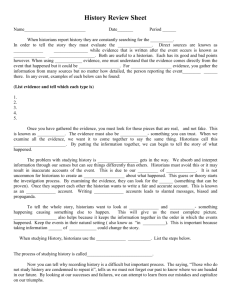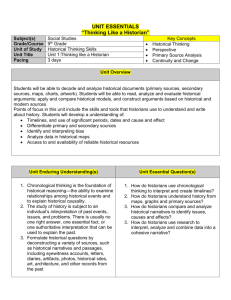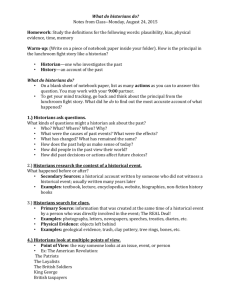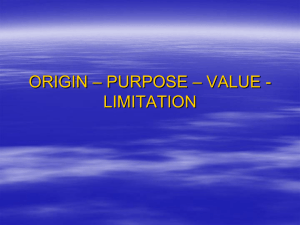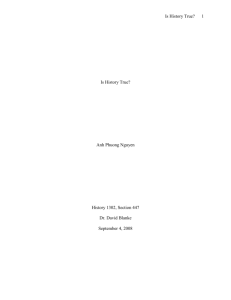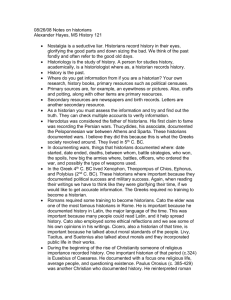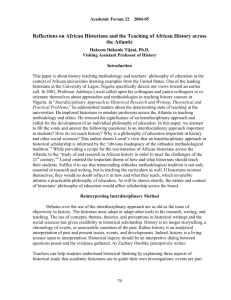Using Primary Sources in History: A Guide
advertisement
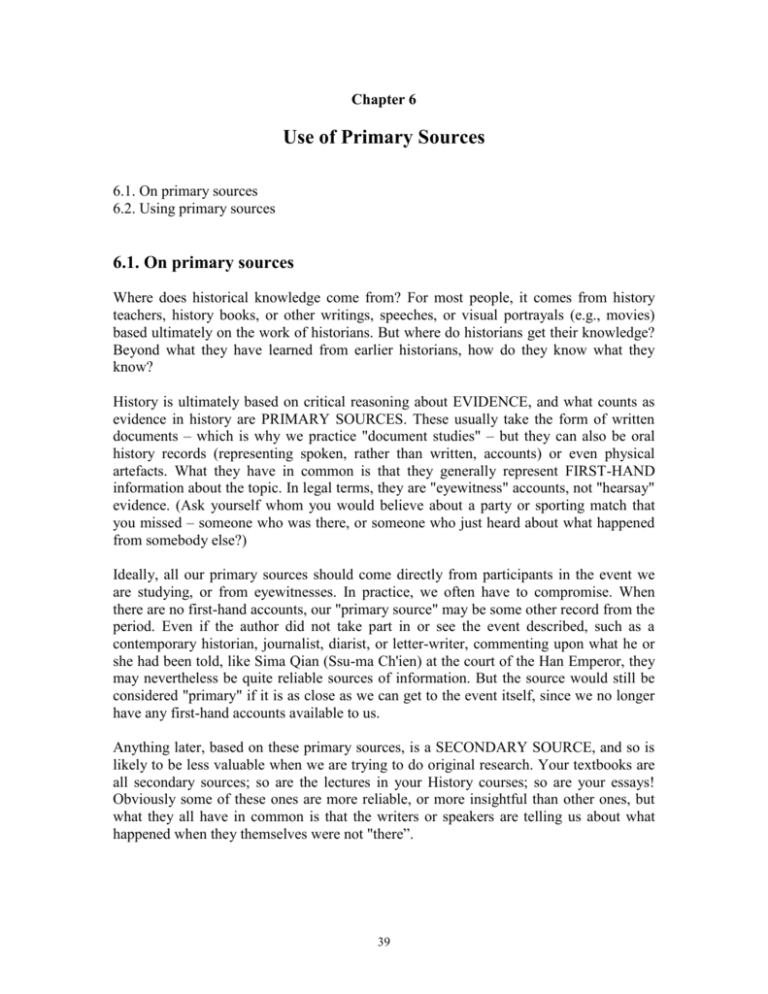
Chapter 6 Use of Primary Sources 6.1. On primary sources 6.2. Using primary sources 6.1. On primary sources Where does historical knowledge come from? For most people, it comes from history teachers, history books, or other writings, speeches, or visual portrayals (e.g., movies) based ultimately on the work of historians. But where do historians get their knowledge? Beyond what they have learned from earlier historians, how do they know what they know? History is ultimately based on critical reasoning about EVIDENCE, and what counts as evidence in history are PRIMARY SOURCES. These usually take the form of written documents – which is why we practice "document studies" – but they can also be oral history records (representing spoken, rather than written, accounts) or even physical artefacts. What they have in common is that they generally represent FIRST-HAND information about the topic. In legal terms, they are "eyewitness" accounts, not "hearsay" evidence. (Ask yourself whom you would believe about a party or sporting match that you missed – someone who was there, or someone who just heard about what happened from somebody else?) Ideally, all our primary sources should come directly from participants in the event we are studying, or from eyewitnesses. In practice, we often have to compromise. When there are no first-hand accounts, our "primary source" may be some other record from the period. Even if the author did not take part in or see the event described, such as a contemporary historian, journalist, diarist, or letter-writer, commenting upon what he or she had been told, like Sima Qian (Ssu-ma Ch'ien) at the court of the Han Emperor, they may nevertheless be quite reliable sources of information. But the source would still be considered "primary" if it is as close as we can get to the event itself, since we no longer have any first-hand accounts available to us. Anything later, based on these primary sources, is a SECONDARY SOURCE, and so is likely to be less valuable when we are trying to do original research. Your textbooks are all secondary sources; so are the lectures in your History courses; so are your essays! Obviously some of these ones are more reliable, or more insightful than other ones, but what they all have in common is that the writers or speakers are telling us about what happened when they themselves were not "there”. 39 6.2. Using primary sources Historians need to know how to use primary sources intelligently. “But”, you may be thinking, “I'm not a historian. I'm not even sure I want to be a history major!” That does not matter. What is important to remember is that what you are learning here are transferable skills, which you can use in other university courses or in any job that calls for something beyond the abilities of a clerk. A journalist uses primary sources all the time, and so does every government official or business executive – or executive-in-themaking – who is asked to "find out" about some topic and "report back" on it. If you know how to use historical primary sources, you will be well equipped to handle this. There are three basic elements that historians need to consider in using primary sources: 1. LOCATING primary sources. If you go on to do serious research in history, whether in second and third-year courses, as a post-graduate doing MPhil or PhD, or as a professional, this will be one of your major tasks: to FIND the sources that you need. You will constantly ask yourself, "What do I want to know about this event or this period? What are the kinds of primary source materials that might exist? Who might have taken part in this, or seen this, and left some record of it? And if these records have survived, where might they be, and how can I get to them?” The historian must be a detective! 2. READING primary sources. This may sound straightforward, but often it is not. For many kinds of history, the sources may be in a language that you do not understand, e.g., French or Classical Chinese. But even if you think you "know" the language, you may not always be 100% sure of the meanings of a text. Sometimes the words themselves are unfamiliar; sometimes the words make sense, but the sentences do not, because the author is using structures or images that lie outside your "normal" language or cultural background. And even when you are sure that you understand each individual sentence, you still need to comprehend the author's ARGUMENT, to see what point he or she is trying to make, and what evidence and logic are deployed to make that point, including emotional language designed to sway opinions. It is your responsibility to understand the text. Unlike a conversation with a friend or family member, in which both parties share a mutual responsibility to communicate clearly, historical sources do not "owe" you anything! You need to take the time, and use the tools needed (including a good dictionary, which should always be beside you as you read) to make sure that you comprehend them fully. Obviously, this is a most important transferable skill. If you know how to read a document carefully, getting its full meaning, not just a general impression of what it is about; you have developed a very valuable talent for ANY course or executive job. 40 3. ANALYSING primary sources. Of each document, we should ask: How reliable is it? What are its limitations, its biases, or blind spots? What is its historical significance? What does it tell us that we did not already know? How does it affect what we already "knew"? Does it expand, modify, or contradict our previous "knowledge"? Answering questions like this is a lifetime's work for historians. In approaching such broad themes, it is often useful to start out with more specific, smaller questions about your source: 1. WHO wrote the document? Ideally, we would like to know not just the author's name, but his or her position (office, title), social class, nationality or ethnicity, religion, political leanings, and anything else that might "explain" him or her. (If the author is a group, ideally we would like to know the composition of that group.) 2. WHERE was it written or published? This will not always be relevant, but sometimes it may suggest something about authors who are otherwise imperfectly known. We recognise that anything published in Pyongyang (North Korea) over the last 50 years is likely to represent a particular political viewpoint, even if we do not know the author's name. 3. WHEN was it written? The best primary source is often that which is composed closest in time to the event described; your memory of what you had for breakfast this morning is likely to be clearer than your memory of what you ate on your 10th birthday. Many men and women write their memoirs only in the later stages of their life, when their memories are failing and they are trying to polish their image retrospectively, so these are less valuable than contemporary letters. On the other hand, sometimes delay gives more time for mature reflection. 4. FOR WHOM was it written? Every document -- every statement any of us makes -has an intended AUDIENCE. Sometimes this is only you, as in a diary or poem that we do not wish anyone else to read (though we may dream of an ideal, imaginary reader who will come along someday and appreciate it). Sometimes this is one other person, as in a private letter. Sometimes it is a group: e.g., a committee, a social club, or political faction. Sometimes it is the public, as in a speech, a government report, a letter to the newspaper, or a book. Often it is some combination of the above: you may write a report for your boss that you expect to be passed on to others in the organisation, or a private letter that you know may eventually be published. This leads us to … 5. WHY was it written? In some ways, this is the most important question. Every utterance has a PURPOSE. Sometimes students just assume that the only purpose is “to tell the truth”, but a moment's reflection will tell us that is not an adequate answer. The sky is blue, but only one-year-old children who have just learned to talk will go around all the time saying, "The sky is blue! The sky is blue!" as if they have just discovered it. The rest of us only bother to tell the truth (or, for that matter, a lie) when it serves some purpose: to convince our audience to act a certain way or believe a certain idea, to fulfil 41 an assignment, to pass a test, to start up a conversation with someone, to make money, to enhance our reputation and earn a promotion or win an election, etc. There is nothing wrong with this, so do not assume that discovering why a document was written somehow discredits it. Your job as historians is NOT to try to find some "objective" source that will tell you "the truth" for its own sake, with no other purpose, and then reject everything else as biased and subjective. It is to try to understand the purpose of EVERY source, and use this knowledge to help you assess its usefulness in your own pursuit of truth. All of these questions may be answered in part by internal evidence (i.e., by inferences from the document itself), in part by external evidence (what you can learn about the document, its author, and its context from other sources, primary or secondary). Most of the time, even in serious professional scholarship, our answers to these questions are incomplete. In a first-year history course, they most certainly will be! But it is important that we ask them anyway. Never assume, unthinking, that it does not matter who wrote a document, or where, when, for whom, and why it was written. This insight should be valuable to you in other academic courses, and throughout your life. Using the Internet and the World Wide Web presents special problems and challenges. Please review the materials in chapter 4 for guidance on using the Internet for historical study. You will also want to keep in mind that materials found on the Internet must still be fully cited when appropriate. 42



